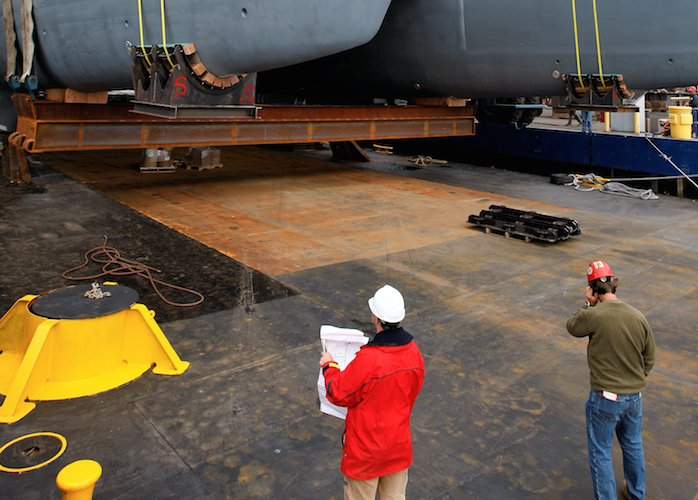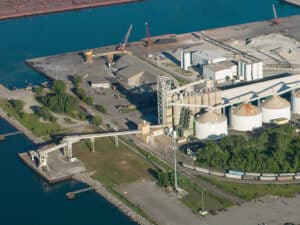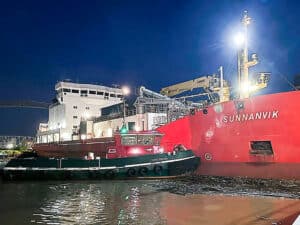![Tom Frazier aground and listing to starboard on Feb. 11, 2024. [Photo: U.S. Coast Guard]](https://www.marinelog.com/wp-content/uploads/2025/06/Towboataground-300x225.jpg)
A Q&A with The Shearer Group’s Greg Beers and Cory Wood
Written by Heather Ervin
Greg Beers reviews blueprints at a shipyard.
Since The Shearer Group is celebrating 10 years of being in business this year, who better to feature in the CEO Spotlight than two its head guys—Gregory Beers and Cory Wood. Back in 2010, both men purchased the assets of Shearer & Associates Inc. from Ed Shearer to form The Shearer Group Inc., which provides naval architecture, marine engineering, and marine surveying services.
Prior to establishing The Shearer Group, Beers and Wood had been working together for 15 years. They formed Bristol Harbor Group Inc., a full-service naval architecture, marine engineering, and consulting firm in Bristol, R.I., out of their college house at the University of Michigan in 1993. They took that experience and applied it to what Ed Shearer built at Shearer & Associates when they formed the company.
Today, Beers and Wood continue to run both companies, although the two are separate legal entities. The sister companies work together in terms of resource allocation and mutual support. We talked to The Shearer Group to find out what Beers and Wood are up to today and what we can expect from them in the near future.
Marine Log (ML): Would you say that your particular focus is on the inland sector? If so, how specialized are its demands?
Greg Beers and Cory Wood (TSGI): Yes, The Shearer Group Inc. (TSGI) focuses on the inland sector. We also own Bristol Harbor Group Inc., which focuses on the bluewater sector and government clients. The inland sector does require some unique skills and knowledge. One of the most obvious challenges is that inland operators always want to push as much power through a propulsor as possible. This is due to the fact that inland vessels are draft limited and thus can’t turn as big a wheel as might be optimum for the situation. This requirement, combined with the shallow-water hydrodynamic effects on the propulsor and appendages as well as on the hull itself, can be a very difficult problem to solve.
The inland sector is composed of many diverse and smaller companies. Design and engineering support projects tend to be shorter in duration and are scheduled with less lead time as compared to our typical projects at Bristol Harbor Group. Maintaining sufficient flexibility in our project scheduling to allow for known projects as well as the “known unknown” projects is certainly a challenge.
The inland marine market encompasses more 15,000 U.S. flagged vessels (barges, towboats, ferries, marine construction equipment, etc.), so each design has its own unique sets of challenges and requirements. The Shearer Group specializes in custom designs to meet any unique challenge an operator may need to overcome.
ML: Tell us some more about how The Shearer Group and Bristol Harbor Group interact.
TSGI: We own 100% of both companies. The companies are separate legal entities, but we try to develop as much synergy as possible between the two. The support goes in both directions. It is not uncommon for Bristol Harbor Group personnel to be working on The Shearer Group projects at the same time as The Shearer Group personnel are supporting Bristol Harbor Group projects. Between the two companies, we have a wealth of experience and skill sets and we try to apply the best fit to every project.
ML: The Shearer Group Inc. is celebrating its 10-year anniversary this year. Can you both speak on some company milestones you experienced in that decade?
TSGI: Working with Ed Shearer, P.E., over the last 10 years has been wonderful both professionally and personally. Ed has been a great partner and friend, which is more than we could have reasonably expected. Ed has 50-plus years of knowledge, experience, and contacts in the inland market that we try to pass along to our younger employees as much as possible.
Promoting Joshua Sebastian, P.E., as The Shearer Group’s engineering manager was a fortuitous decision. He had previously worked with us at Bristol Harbor Group Inc., so he had a head start in implementing our corporate ethos here. He knows how we do things and has done a wonderful job steering The Shearer Group. In addition to his engineering chops, Josh also has a strong interest in business development. Under his day-to-day leadership, The Shearer Group has grown significantly, adding employees and growing a diverse clientele that includes operators, shipyards, and government entities.
ML: The Shearer Group recently delivered a 23,000-bbl tank barge built by Southwest Shipyard in Houston, Texas. What made this project unique, and can you touch on some other significant projects you have in the works or that you’ve recently completed?
TSGI: This was a custom design that did not fall into the typical inland tank barge designs. The vessel had very strict draft and capacity requirements to enable it to function in the areas required while delivering the necessary amount of jet fuel. The barge has a unique manifold and recirculation system installed, along with a climate-controlled operators station. Additionally, the trunk top height had to be minimized while at the same time the length, breadth, and operating draft were restricted by local conditions.
In 2017, The Shearer Group was awarded a design contract for a 70-vehicle, 500-passenger ferry for the State of Texas Department of Transportation (TxDOT). Our design incorporates a diesel electric propulsion system with 1.4MWhr of energy storage. The vessel is currently under construction and The Shearer Group continues to support TxDOT by providing construction oversight services. When this ferry is delivered in 2021, it will have the largest energy storage capacity of any U.S.-flagged ferry in operation.
The Shearer Group continues to be a leader in introducing Z-drive towboats to the inland sector. Ed Shearer designed his first Z-drive for Southern Towing Company in 2008, and they are still building The Shearer Group-designed towboats.
SCF was the first triple-screw Z-drive on the U.S. rivers, and when delivered, had the most horsepower of any Z-drive on the rivers at 6,600 hp. of installed power. This design was the product of extensive Computational Fluid Dynamics (CFD) analysis to optimize the hull shape for improving flow characteristics for the center propeller while improving overall hull efficiency as compared to typical inland towboat designs. SCF originally took delivery of three of these vessels and had a fourth delivered in 2019.
SCF has also recently engaged The Shearer Group to develop a dual-fuel LNG/diesel Z-drive conversion package for two of their existing vessels that are operating in the marine highway operations on the Lower Mississippi River. The Shearer Group built off its experience (and that of Bristol Harbor Group) to work with the U.S. Coast Guard to develop guidelines based on the IGF Code with considerations provided for inland towboats and the current state of NG fumigation technology.
The Shearer Group has always had a strong backlog of barge design work and that continues. During the past year, we have completed the designs of multiple dump scows, dredge barges, and dry docks. These projects typically incorporate advanced structural analysis (including FEA).
ML: Finally, what do you expect to see happen in the industry and at The Shearer Group, Inc. over the next 10 years?
TSGI: We assume that there will be a fair amount of consolidation in the towboat space due to Subchapter M. We believe this will continue the demand for new, Subchapter M-compliant towboats, and we stand ready to answer that need.
We have been on the cutting edge of applying marine technology to the inland marine industry by being a leader on subjects like diesel electric, energy storage, and LNG as a fuel, while also applying the latest in engineering technology, such as FEA and CFD.
The Shearer Group will continue to grow and evolve over the next decade. Our talented staff is always bettering themselves, and we look forward to watching them grow with our growing company.




